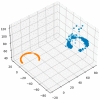GNSS Based Low-Cost Magnetometer Calibration
- PMID: 36366145
- PMCID: PMC9694045
- DOI: 10.3390/s22218447
GNSS Based Low-Cost Magnetometer Calibration
Abstract
With the development of MEMS sensors, the magnetometer has increasingly become a part of various wearable devices. The magnetometer measures the intensity of the magnetic field in all three axes, resulting in a 3D vector-direction and power. Calibration must be done before using a magnetometer, especially in wearable electronics, due to the low quality of the sensor and high proximity to other electromagnetic emission sources. Several magnetometer calibration algorithms exist in the literature, with most of them requiring multi-sided rotation. However, such calibration is highly impractical when the sensor is mounted on larger objects, e.g., vehicles, which cannot easily be rotated. Vehicles contain a large amount of ferromagnetic soft and hard material that affects the measured magnetic field. A magnetometer can be useful for an INS system in a car as long as it does not drift over time. This article describes how to calibrate a magnetometer using the GNSS motion vector. The calibration is performed using data from the initial section of the vehicle's trajectory. The quality of the calibration is then validated using the remaining section of the trajectory, comparing the deviation between the azimuth obtained by GNSS and by the calibrated magnetometer. Based on the azimuth and speed of the vehicle, we predicted the position of the vehicle and plotted the prediction on the map. The experiment showed that such calibration is functional. The uncalibrated data were unusable due to the strong effect of ferromagnetic soft and hard materials in the vehicle.
Keywords: GNSS; calibration; data acquisition unit; magnetometer.
Conflict of interest statement
The authors declare no conflict of interest.
Figures







References
-
- Wu J. Real-Time Magnetometer Disturbance Estimation via Online Nonlinear Programming. IEEE Sens. J. 2019;19:4405–4411. doi: 10.1109/JSEN.2019.2901925. - DOI
-
- Renaudin V., Afzal M.H., Lachapelle G. Complete triaxis magnetometer calibration in the magnetic domain. J. Sens. 2010;2010:967245. doi: 10.1155/2010/967245. - DOI
-
- Vasconcelos J.F., Elkaim G., Silvestre C., Oliveira P., Cardeira B. Geometric approach to strapdown magnetometer calibration in sensor frame. IEEE Trans. Aerosp. Electron. Syst. 2011;47:1293–1306. doi: 10.1109/TAES.2011.5751259. - DOI
-
- Li Q., Griffiths J.G. Least squares ellipsoid specific fitting; Proceedings of the Geometric Modeling and Processing 2004; Beijing, China. 13–15 April 2004; pp. 335–340. - DOI
-
- Li S., Cheng D., Gao Q., Wang Y., Yue L., Wang M., Zhao J. An Improved Calibration Method for the Misalignment Error of a Triaxial Magnetometer and Inertial Navigation System in a Three-Component Magnetic Survey System. Appl. Sci. 2020;10:6707. doi: 10.3390/app10196707. - DOI
Grants and funding
LinkOut - more resources
Full Text Sources

